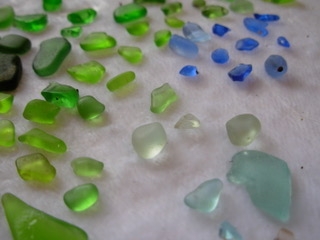What do sea glass and Hellmann’s Mayonnaise have in common?
I grew up eating Hellmann’s Real Mayonnaise (which my mother pronounced “my-O-nayz”) and Gulden’s Spicy Brown Mustard. They came in glass jars. As did Heinz Tomato Ketchup. And every other condiment I can think of at the moment.
No more.
I’ve looked and looked. One cannot find Hellmann’s mayonnaise or Gulden’s mustard in a glass jar, only plastic. Ditto ketchup. And in squeeze bottles, to boot! I hate them! I suppose I should say “dislike,” but that would not be less than truthful. There is nothing I like about these plastic containers:
- First, they don’t work. It isn’t easy to get the goods out of them. And when a squeeze bottle version, you can never get the last bit out.
- Second, they are environmentally stupid. Plastic, need I say more?
- Third, the plastic feels yukky in my hands; and I worry about the plastic mingling with what’s inside it, especially the tomato ketchup.
- Lastly, I resent not having a choice. Why is it only available in plastic?
What was wrong with the glass?
I’m sure the corporations that market these brands are saving a bundle on shipping. They’re not considering other costs, environmental and, as in my case, experiential and sensate.
Glass is simply silica, sand transformed by heat with some soda ash and a few minerals thrown in. (For instance, if you’d like some red glass, you’d add some gold). So unless you want it red, glass is a pretty inexpensive proposition.
Growing up on the New Jersey shore, we would walk the beach and find all kinds of stuff, sometimes treasures, sometimes trash. One treasure was sea glass. Beautiful bits of glittering glass worn smooth by the ocean currents and tumbling sand. Green, white, brown, rare blue. Very rare: red and orange. It washed up on our beaches, and we joyfully collected the magical bits.
They used to take NYC’s garbage out on barges and dump it in the ocean off that NJ shore, or so I was told, in those “good old days” of glass bottles and jars. It was that awful action that seeded the beauty of sea glass.
You can hardly find sea glass along the Atlantic coast anymore. Any U.S. coast, really. I suppose I can thank only the boaters who throw over their beer bottles (green and brown) for the rare bits that show up today. With few glass jars or non-beer bottles, now sea glass is so rare a handful can cost hundreds of dollars. It is set in silver and made into jewelry.
Frankly, frankly, I think Hellmann’s, Heinz, and everybody else should return to glass. I think the empties should be loaded onto barges and dumped into the ocean. Sand to container glass to sea glass. Repeat.
A beautiful cycle. Much better than plastic in every way! Except maybe shipping.


